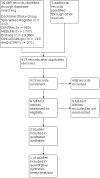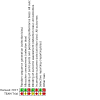Treatments for unruptured intracranial aneurysms
- PMID: 33971026
- PMCID: PMC8109849
- DOI: 10.1002/14651858.CD013312.pub2
Treatments for unruptured intracranial aneurysms
Abstract
Background: Unruptured intracranial aneurysms are relatively common lesions in the general population, with a prevalence of 3.2%, and are being diagnosed with greater frequency as non-invasive techniques for imaging of intracranial vessels have become increasingly available and used. If not treated, an intracranial aneurysm can be catastrophic. Morbidity and mortality in aneurysmal subarachnoid hemorrhage are substantial: in people with subarachnoid hemorrhage, 12% die immediately, more than 30% die within one month, 25% to 50% die within six months, and 30% of survivors remain dependent. However, most intracranial aneurysms do not bleed, and the best treatment approach is still a matter of debate.
Objectives: To assess the risks and benefits of interventions for people with unruptured intracranial aneurysms.
Search methods: We searched CENTRAL (Cochrane Library 2020, Issue 5), MEDLINE Ovid, Embase Ovid, and Latin American and Caribbean Health Science Information database (LILACS). We also searched ClinicalTrials.gov and the WHO International Clinical Trials Registry Platform from inception to 25 May 2020. There were no language restrictions. We contacted experts in the field to identify further studies and unpublished trials.
Selection criteria: Unconfounded, truly randomized trials comparing conservative treatment versus interventional treatments (microsurgical clipping or endovascular coiling) and microsurgical clipping versus endovascular coiling for individuals with unruptured intracranial aneurysms.
Data collection and analysis: Two review authors independently selected trials for inclusion according to the above criteria, assessed trial quality and risk of bias, performed data extraction, and applied the GRADE approach to the evidence. We used an intention-to-treat analysis strategy.
Main results: We included two trials in the review: one prospective randomized trial involving 80 participants that compared conservative treatment to endovascular coiling, and one randomized controlled trial involving 136 participants that compared microsurgical clipping to endovascular coiling for unruptured intracranial aneurysms. There was no difference in outcome events between conservative treatment and endovascular coiling groups. New perioperative neurological deficits were more common in participants treated surgically (16/65, 24.6%; 15.8% to 36.3%) versus 7/69 (10.1%; 5.0% to 19.5%); odds ratio (OR) 2.87 (95% confidence interval (CI) 1.02 to 8.93; P = 0.038). Hospitalization for more than five days was more common in surgical participants (30/65, 46.2%; 34.6% to 58.1%) versus 6/69 (8.7%; 4.0% to 17.7%); OR 8.85 (95% CI 3.22 to 28.59; P < 0.001). Clinical follow-up to one year showed 1/48 clipped versus 1/58 coiled participants had died, and 1/48 clipped versus 1/58 coiled participants had become disabled (modified Rankin Scale > 2). All the evidence is of very low quality.
Authors' conclusions: There is currently insufficient good-quality evidence to support either conservative treatment or interventional treatments (microsurgical clipping or endovascular coiling) for individuals with unruptured intracranial aneurysms. Further randomized trials are required to establish if surgery is a better option than conservative management, and if so, which surgical approach is preferred for which patients. Future studies should include consideration of important characteristics such as participant age, gender, aneurysm size, aneurysm location (anterior circulation and posterior circulation), grade of ischemia (major stroke), and duration of hospitalizations.
Copyright © 2021 The Cochrane Collaboration. Published by John Wiley & Sons, Ltd.
Conflict of interest statement
Felipe Gomes de Barros Pontes: none known.
Edina Mariko Koga da Silva: none known.
Jose Carlos Costa Baptista‐Silva: none known.
Vladimir Tonello de Vasconcelos: none known.
Figures
Update of
- doi: 10.1002/14651858.CD013312
References
References to studies included in this review
Darsaut 2017 {published data only}
References to studies excluded from this review
Brilstra 2003 {published data only}
-
- Brilstra EH, Rinkel GJE, de Graaf Y, Sluzewski M, Lo RTH, Tulleken CAF. Quality of life after treatment of unruptured intracranial aneurysms by neurosurgical clipping or by embolization with coils. Cerebrovascular Disease 2003;17:44-52. - PubMed
Gerlach 2007 {published data only}
-
- Gerlach R, Beck J, Setzer M, Vatter H, Berkefeld J, Du Mesnil de Rochemont R, et al. Treatment related morbidity of unruptured intracranial aneurysms: results of a prospective single centre series with an interdisciplinary approach over a 6 year period (1999–2005). Journal of Neurology, Neurosurgery, and Psychiatry 2007;78(8):864-71. - PMC - PubMed
Ruan 2015 {published data only}
-
- Ruan C, Long H, Sun H, He M, Yang K, Zhang H, et al. Endovascular coiling vs surgical clipping for unruptured intracranial aneurysm: a meta-analysis. British Journal of Neurosurgery 2015;29(4):1-8. - PubMed
Wiebers 2003 {published data only}
-
- Wiebers DO, Whisnant JP, Huston J 3rd, Meissner I, Brown RD Jr, Piepgras DG, International Study of Unruptured Intracranial Aneurysms Investigators. Unruptured intracranial aneurysm: natural history, clinical outcome, and risks of surgical and endovascular treatment. Lancet 2003;362(9378):103-10. - PubMed
Additional references
Alshekhlee 2010
-
- Alshekhlee A, Mehta S, Edgell RC, Vora N, Feen E, Mohammadi A, et al. Hospital mortality and complications of electively clipped or coiled unruptured intracranial aneurysm. Stroke 2010;41(7):1471-6. - PubMed
Atkins 2004
Barker 2004
-
- Barker FG, Amin-Hanjani S, Butler WE, Hoh BL, Rabinov JD, Pryor JC, et al. Age-dependent differences in short-term outcome after surgical or endovascular treatment of unruptured intracranial aneurysms in the United States, 1996–2000. Neurosurgery 2004;54(1):18-30. - PubMed
Bhatia 2011
-
- Bhatia S, Sekula RF, Quigley MR, Williams R, Ku A. Role of calcification in the outcomes of treated, unruptured, intracerebral aneurysms. Acta Neurochirurgica 2011;153(4):905-11. - PubMed
Cowan 2007
-
- Cowan JA Jr, Ziewacz J, Dimick JB, Upchurch GR Jr, Thompson G. Use of endovascular coil embolization and surgical clip occlusion for cerebral artery aneurysms. Journal of Neurosurgery 2007;107(3):530-5. - PubMed
Dechartres 2013
Deeks 2011
-
- Deeks JJ, Higgins JPT, Altman DG, Cochrane Statistical Methods Group. Chapter 9: Analysing data and undertaking meta-analysis. In: Higgins JP, Green S, editor(s). Cochrane Handbook for Systematic Reviews of Interventions Version 5.1.0 (updated March 2011). The Cochrane Collaboration, 2011. Available from training.cochrane.org/handbook/archive/v5.1/.
Etminan 2016
-
- Etminan N, Rinkel GJ. Unruptured intracranial aneurysms: development, rupture and preventive management. Nature Reviews Neurology 2016;12(12):699-713. - PubMed
GRADEpro GDT 2015 [Computer program]
-
- McMaster University (developed by Evidence Prime) GRADEpro GDT 2015. Hamilton (ON): McMaster University (developed by Evidence Prime), 2015. Available at gradepro.org.
Greving 2014
-
- Greving JP, Wermer MJ, Brown RD Jr, Morita A, Juvela S, Yonekura M, et al. Development of the PHASES score for prediction of risk of rupture of intracranial aneurysms: a pooled analysis of six prospective cohort studies. Lancet Neurology 2014;13(1):59–66. - PubMed
Hackenberg 2018
-
- Hackenberg KAM, Hänggi D, Etminan N. Unruptured intracranial aneurysms. Stroke 2018;49(9):2268-75. - PubMed
Higgins 2011
-
- Higgins JP, Green S, editor(s). Cochrane Handbook for Systematic Reviews of Interventions Version 5.1.0 (updated March 2011). The Cochrane Collaboration, 2011. Available from training.cochrane.org/handbook/archive/v5.1/.
Higgins 2021
-
- Higgins JP, Thomas J, Chandler J, Cumpston M, Li T, Page MJ, Welch VA, editor(s). Cochrane Handbook for Systematic Reviews of Interventions Version 6.2 (updated February 2021). Cochrane, 2021. Available from training.cochrane.org/handbook. - PMC - PubMed
Hoh 2009
-
- Hoh BL, Chi Y-Y, Dermott MA, Lipori PJ, Lewis SB. The effect of coiling versus clipping of ruptured and unruptured cerebral aneurysms on length of stay, hospital cost, hospital reimbursement, and surgeon reimbursement at the University of Florida. Neurosurgery 2009;64(4):614-21. - PubMed
Johnston 2001
-
- Johnston SC, Zhao S, Dudley RA, Berman MF, Gress DR. Treatment of unruptured cerebral aneurysms in California. Stroke 2001;32(3):597-605. - PubMed
Niskanen 2005
-
- Niskanen M, Koivisto T, Rinne J, Roinkainen A, Pirskanen S, Saari T, et al. Complications and postoperative care in patients undergoing treatment for unruptured intracranial aneurysms. Journal of Neurosurgical Anesthesiology 2005;17(2):100-5. - PubMed
Qureshi 2007
-
- Qureshi AI, Janardhan V, Hanel RA, Lanzino G. Comparison of endovascular and surgical treatments for intracranial aneurysms: an evidence-based review. Lancet Neurology 2007;6(9):816-25. - PubMed
Rackauskaite 2018
Raftopoulos 2003
-
- Raftopoulos C, Goffette P, Vaz G, Ramzi N, Scholtes J-L, Wittebole X, et al. Surgical clipping may lead to better results than coil embolization: results from a series of 101 consecutive unruptured intracranial aneurysms. Neurosurgery 2003;52(6):1280-90. - PubMed
Regli 1999
-
- Regli L, Uske A, Tribolet N. Endovascular coil placement compared with surgical clipping for the treatment of unruptured middle cerebral artery aneurysms: a consecutive series. Journal of Neurosurgery 1999;90(6):1025-30. - PubMed
Review Manager 2020 [Computer program]
-
- Nordic Cochrane Centre, The Cochrane Collaboration Review Manager 5 (RevMan 5). Version 5.4. Copenhagen: Nordic Cochrane Centre, The Cochrane Collaboration, 2020.
Sharma 2013
-
- Sharma M, Brown B, Madhugiri V, Cuellar-Saens H, Soning A, Ambekar S, et al. Unruptured intracranial aneurysms: comparison of perioperative complications, discharge disposition, outcome, and effect of calcification, between clipping and coiling: a single institution experience. Neurology India 2013;61(3):270-6. - PubMed
Smith 2015
-
- Smith TR, Cote DJ, Dasenbrock HH, Hamade YJ, Zammar SG, El Tecle NE, et al. Comparison of the efficacy and safety of endovascular coiling versus microsurgical clipping for unruptured middle cerebral artery aneurysms: a systematic review and meta-analysis. World Neurosurgery 2015;84(4):942-53. - PubMed
Thompson 2015
-
- Thompson BG, Brown RD, Amin-Hanjani S, Broderick JP, Cockroft KM, Connolly ES, on behalf of the American Heart Association Stroke Council, Council on Cardiovascular and Stroke Nursing, and Council on Epidemiology and Prevention. Guidelines for the management of patients with unruptured intracranial aneurysms. Stroke 2015;46(8):2368-400. - PubMed
Vlak 2011
-
- Vlak MHM, Algra A, Brandenburg R, Rinkel GJE. Prevalence of unruptured intracranial aneurysms, with emphasis on sex, age, comorbidity, country, and time period: a systematic review and meta-analysis. Lancet Neurology 2011;10(7):626-36. - PubMed
References to other published versions of this review
Publication types
MeSH terms
LinkOut - more resources
Full Text Sources
Other Literature Sources
Medical



